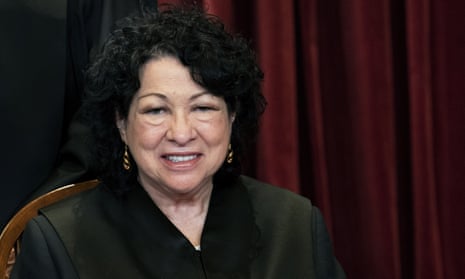Justice Sonia Sotomayor has revealed that changes have been made in the supreme court’s structure of oral arguments following studies confirming what women on the court have long noticed – that female justices were more prone to being interrupted by male justices and attorneys.
Speaking at a New York University School of Law event on Wednesday, Sotomayor said the new format now allows justices to ask questions individually, in order of seniority, after an attorney’s time is up.
The improvement has had an “enormous impact”, she said, as first reported by CNN.
“I … found that my colleagues are much more sensitive than they were before. You’ll see us, even now, when we’re speaking, a judge will say, ‘I’m sorry, did I interrupt you?’” Sotomayor said, adding: “That did not happen as much before.”
Tonja Jacobi, a researcher at Northwestern University, told the Guardian on Thursday that, her team had found that Sotomayor was the most interrupted justice on the supreme court bench in the 2019 term.
The 2020 supreme court term, which was conducted remotely because of the coronavirus pandemic, when the majestic court building in Washington DC was closed, is still being examined.
Sotomayor herself has cited a 2017 study conducted by Jacobi and fellow Northwestern researcher Dylan Schweers, which found that “judicial interactions at oral argument are highly gendered, with women being interrupted at disproportionate rates by their male colleagues, as well as by male advocates.
“Seniority also has some influence on oral arguments, but primarily through the female justices learning over time how to behave more like male justices, avoiding traditionally female linguistic framing in order to reduce the extent to which they are dominated by the men,” the study said.
Sotomayor said that before the changes, she noticed the pattern of interruption.
“Without question,” she said, adding: “I respond in a way that perhaps I shouldn’t, which is, I interrupt back.”
The 67-year-old justice has served on the court for 12 years. She was nominated by Barack Obama and now finds herself in a minority of three on the liberal wing of the nine-member bench, after several opportunities arose for Donald Trump to nominate conservative justices during his one-term presidency.
She also recognized that the tendency for men to interrupt women occurs not only in the courts but in society as a whole.
“Most of the time women say things and they are not heard in the same way as men who might say the identical thing,” she said.
Jacobi told the Guardian it was great to have her study acknowledged but that more work needed to be done.
“I do have more recent results showing that the effect of the rule change, at least initially – in the final 10 cases heard in the 2019 term telephonically – was to enable the chief [Chief Justice John Roberts] to interrupt the female justices more, Sotomayor in particular,” she said.
“It also gave him the discretion to give more airtime to the conservative justices, at the cost of the liberal justices,” Jacobi added, referring to a 2020 study she did with other researchers that found that Sotomayor was the most interrupted justice – by both male advocates and male justices.
Jacobi and her co-authors are conducting a follow-up to see if patterns changed in the 2020 telephonic term, as well as a broader study of whether things have changed more generally since 2017, in regards to interruptions and chief justice interventions.
“For now I would say that it is wonderful that the court is taking this seriously and making efforts to change, but it is a process that requires repeated checking in on, to make sure that bad habits don’t emerge even under new rules, as our 2019 results suggest they did,” Jacobi added.
Another result of the new changes is that Justice Clarence Thomas, the most senior justice who has for years been known for rarely participating in sessions, asked questions during each argument last term and has become a more active voice during court hearings.
The supreme court will rule on several significant cases this term.
